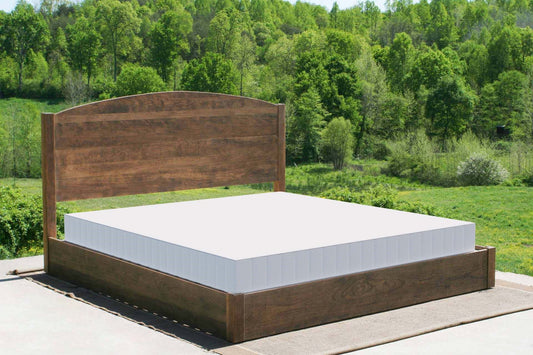How Do You Know If Furniture Is Non-Toxic?
Matt Solid
How To Know If Furniture Is Non-Toxic?
Customers often find us in search of quality non=toxic furniture that is free from harmful chemicals. They tell us that frequent headaches, eye irritation and even nausea can be caused by the off gassing of Volatile Organic Chemicals (VOCs) from brand new furniture they purchased at a big box store.
Based on the growing number of questions about non-toxic furniture, we created this blog to share what we have learned over the years about how solid wood, Formaldehyde free furniture can help to create a healthy home. Pease feel free to contact us to learn more about how we address these issues in our furniture.
Why buy non-toxic furniture?
Choosing non-toxic furniture is essential for creating healthy air in your home, especially for families with children or anyone sensitive to chemicals. Non-toxic furniture avoids the use of harmful chemicals like Volatile Organic Compounds (VOCs), Formaldehyde, flame retardants, and Phthalates, all of which can leach into your living space over time. The best way to know if your furniture is non-toxic is to look beyond the surface: check for transparent manufacturing practices, third-party certifications, detailed material lists, and clear product labeling that specifically addresses chemical safety. This proactive approach not only reduces health risks but also supports a more eco-friendly home.
Signs and Indicators of Non-Toxic Furniture
Truly non-toxic furniture is created with a commitment to using natural materials, such as solid hardwood, organic fabrics, and natural oils for finishing. You should look for descriptions highlighting the absence of VOCs, Formaldehyde, PVC, flame retardants, and Phthalates. If the piece is constructed with solid hardwood such as American Cherry, Maple, or Oak and finished with natural, low-VOC oils (like Tung Oil), it’s far less likely to emit harmful chemicals. Avoiding products made from particle board or MDF, which often use strong chemical adhesives, is another indicator of a safer choice.
Importance of Transparency from Manufacturers
Honest and detailed transparency from manufacturers is a key factor. Reliable brands will provide clear, open information about the sourcing of their materials, their finishing processes, and any additional treatments on their furniture. If a manufacturer answers questions directly about chemical use or is forthcoming with manufacturing details, it’s a positive sign.
How to Use Ingredient/Material Lists to Assess Toxicity
Reviewing ingredient and material lists is a practical step in your research. Manufacturers offering genuine non-toxic furniture will openly share what’s inside and what has been left out. Prioritize pieces with clear labels, such as '100% solid wood,' 'finished with natural oil,' or 'untreated organic cotton fabric.' Be wary of vague terms like ‘engineered wood’ or ‘eco-friendly’ unless backed by specific material breakdowns and certifications.
What Are Non-Toxic Materials For Furniture And Which Should You Avoid?
What are non-toxic materials for furniture?
Non-toxic materials for furniture are those that do not release harmful chemicals or VOCs (Volatile Organic Compounds) into your living environment, making them a safe and healthy choice for your home. These materials include solid hardwoods such as Oak, Maple, Cherry, and Walnut, which are prized for both their durability and low toxicity. Additionally, options like organic Hemp, untreated wool, bamboo, and rattan are popular for soft furnishings and upholstered pieces. Choosing chemical-free furniture made with these natural ingredients can significantly reduce your exposure to toxins, especially in households with children and pets.
When selecting non-toxic wood furniture, look for pieces finished with natural oils (such as Tung oil or linseed oil) or water-based, low-VOC finishes. Avoiding harsh chemical treatments and synthetic adhesives further ensures a safe, eco-friendly product. Verify whether a product is truly organic or sustainable by seeking out certifications or clear disclosures from manufacturers.
Safe and Eco-Friendly Materials
Opt for furniture crafted from solid hardwoods—often sourced from sustainably managed forests—to enjoy timeless beauty and excellent air quality.
Upholstery fabrics labeled as organic contributing to a healthier environment typically include GOTS (Global Organic Textile Standard) certified cotton, OEKO-TEX linen, organic Cotton and Hemp, and naturally tanned leather. Always prioritize untreated or minimally treated fibers to avoid hidden chemical risks.

What materials should you avoid in order to reduce toxins in your furniture?
To minimize toxins in your home, avoid furniture made with particleboard, medium-density fiberboard (MDF), and plywood, as these are often bound with adhesives containing formaldehyde -a known respiratory irritant and carcinogen. Similarly, skip items made with PVC (polyvinyl chloride) or synthetic fabrics treated with flame retardants and stain repellents, as they can release persistent organic pollutants and phthalates linked to hormone disruption and developmental issues.
Another category to avoid is polyurethane foam, commonly used in inexpensive sofas, mattresses, or cushions. This material can emit a range of hazardous VOCs, including Toluene and Benzene, particularly when new or exposed to high heat. Being aware of these materials empowers you to make informed, health-forward decisions while shopping.
Common Chemicals used in Furniture and Their Health Effects
Formaldehyde: Found in adhesives, particleboard, and pressed-wood products; causes eye, nose, and throat irritation, and is a known carcinogen.
Phthalates: Used in plastics and synthetic fabrics; linked to hormone disruption and reproductive issues.
Flame Retardants: Common in upholstered furniture and mattresses; associated with thyroid disruption, neurodevelopmental issues, and cancer.
VOCs: Emitted by paint, finishes, and synthetic materials; cause headaches, dizziness, and long-term respiratory problems.
PVC (Polyvinyl Chloride): Used in faux leather and some cushions; releases dioxins and phthalates into the air.
Tips for Prioritizing Safe Materials for Children and Pets
When shopping for children's beds, cribs, or pet-friendly furniture, always choose solid wood construction finished with natural or water-based products and certified non-toxic textiles. Remember, healthy furniture choices make a dramatic difference for your family’s immediate comfort and long-term well-being.
What are the differences between organic, natural, and eco-friendly furniture materials?
Organic furniture: materials are grown and processed without the use of pesticides, synthetic fertilizers, or toxic chemicals—commonly certified by standards like GOTS.
Natural materials refer to those minimally processed from renewable sources (e.g., real wood, bamboo, wool), but may not always be certified organic.
Eco-friendly furniture often describes products made with recycled or sustainably harvested components, focusing on environmental impact but not necessarily toxicity. Understanding these distinctions will help you balance health, environmental, and ethical priorities in your furniture choices.
How To Tell If Your Couch Or Other Furniture Is Toxic?
Determining whether your couch or other pieces of furniture are toxic involves assessing materials, odors, and even your own physical reactions. Many modern furnishings, particularly those made from particleboard, foam, or synthetic fabrics, are known to emit volatile organic compounds (VOCs), which can negatively impact indoor air quality and your health. There are both simple signs and more advanced testing methods that can help you uncover whether your furniture is releasing potentially harmful chemicals, and recognizing these factors is key to creating a safer home.
How to tell if your couch is toxic?
To evaluate if your couch is toxic, start by looking for strong chemical odors when the furniture is new or after it's been closed up in a room—these scents often indicate off-gassing of VOCs from adhesives, foam, and finishes. Check product tags and documentation: if your couch contains materials like polyurethane foam, synthetic dyes, flame retardants, or is made from particleboard with formaldehyde-based adhesives, it's more likely to emit toxic fumes. Visual clues such as flaking foam, peeling finishes, or visible seams in composite wood can also point to synthetic materials with higher chemical emissions. Pay special attention to any discomfort—such as headaches, watery eyes, or respiratory irritation—when sitting near or using your couch.
How do I know if my furniture has VOCs?
Furniture with significant VOC emissions often has a noticeable smell, which may range from sweet and artificial to sharp or alcohol-like. VOCs such as Formaldehyde, Toluene, and Benzene are commonly found in furniture made from particleboard, cheap laminate, synthetic foams, and some fabric treatments. You can check manufacturer material disclosures or request a materials safety data sheet (MSDS) to determine the presence of known VOC sources. Many companies will also disclose whether their furniture meets low-emission standards or is certified by a third party, which can help you identify safer choices.
How can you tell if your current furniture is emitting harmful chemicals?
Beyond relying on your nose or physical symptoms, you can use consumer-level air quality monitors to check for VOC concentration in your home. Devices such as handheld VOC detectors or more advanced indoor air quality monitoring systems can alert you to elevated levels in the room where your suspect furniture is located. For a more precise assessment, professional home air quality testing services can analyze your environment for a comprehensive range of substances, including formaldehyde and other toxins. If your home shows persistently high readings, ventilating the space and contacting the manufacturer for detailed information about the furniture construction are essential next steps. Reducing exposure, especially for babies, children, or pets, should be prioritized if harmful emissions are detected
Symptoms of exposure to toxic furniture
Common symptoms of exposure to off-gassing VOCs include headaches, nausea, eye irritation, increased allergy or asthma symptoms, and even skin reactions. Sensitive groups—like children, pets, or anyone with respiratory conditions—are much more susceptible to these effects. If symptoms improve when you leave home or after spending time away from the suspected furniture, it's a strong indication that your fixtures or their finishes may be the source.
Tips for Finding Affordable Non-Toxic Furniture
Non-toxic doesn’t have to mean out of reach. To find affordable non toxic furniture, shop seasonal sales, check out local makers who use solid wood and natural finishes, and explore refurbished or upcycled options which are often lower in VOC emissions than new particleboard furniture. Ask about material origin, finishes, and any certifications directly from the retailer; transparency is a key sign of a trustworthy brand. Many smaller, regional businesses focus on handcrafted, sustainable furniture that supports the local economy and offers custom options at competitive prices.



